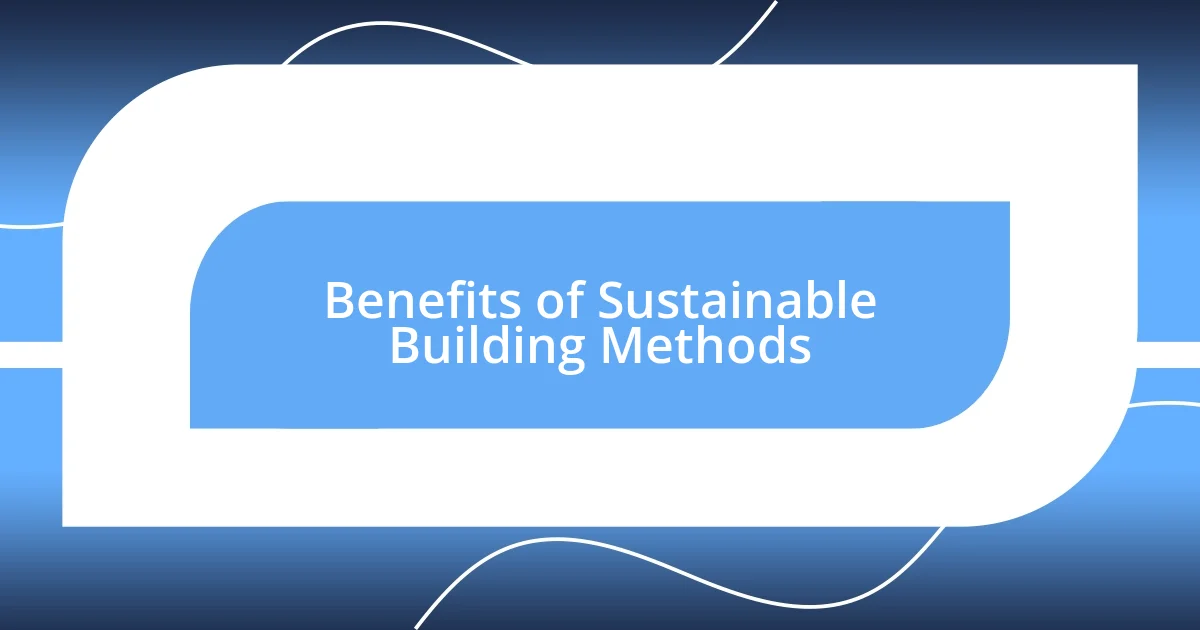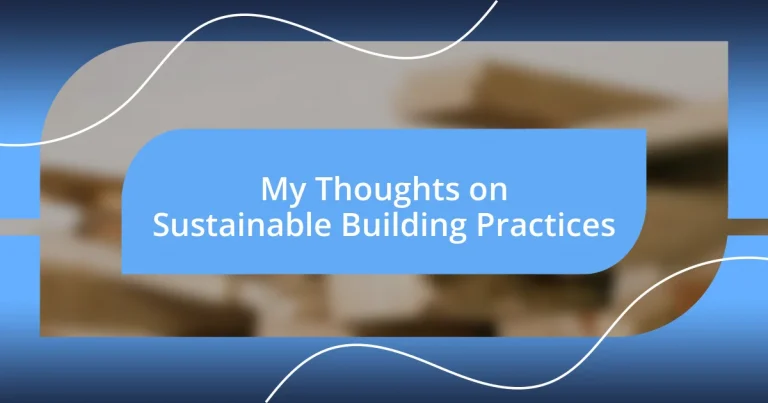Key takeaways:
- Sustainable building practices prioritize minimizing environmental impact through resource efficiency, recycling materials, and using renewable energy sources.
- Key benefits include lower energy costs, enhanced property value, healthier living environments, and reduced carbon footprints.
- Future trends involve modular construction, smart technology integration, and biophilic design to create more sustainable and adaptable spaces.

Understanding Sustainable Building Practices
Sustainable building practices focus on minimizing environmental impact while promoting resource efficiency. I remember the first time I stepped into a green building—right away, the air felt different, fresher. Have you ever thought about how our surroundings shape our well-being? It’s amazing how thoughtful design can enhance not just our health but also our connection to nature.
At its core, sustainable building involves using materials and construction methods that reduce waste and carbon emissions. When I learned about recycled materials being used in construction, it struck me how creativity and innovation can lead to concrete changes—quite literally! Have you considered how many everyday materials could be repurposed if we just opened our minds to possibilities?
Additionally, sustainable practices often encompass energy efficiency and renewable energy sources, like solar panels. The first time I saw a building completely powered by solar, I felt a surge of hope. Isn’t it inspiring to think that the choices we make in building today can create a greener world for future generations? With each brick and beam, we’re not just constructing spaces; we’re shaping a sustainable future.

Benefits of Sustainable Building Methods
Sustainable building methods bring a wealth of benefits that resonate on personal, environmental, and economic levels. I recall visiting a green community where the energy bills were almost nonexistent. It was a small revelation, realizing that what benefits the planet can be equally beneficial for our wallets. Sustainable construction minimizes resource use and waste, which ultimately leads to lower operating costs. Imagine living in a space where not only are your utilities reduced, but you’re also contributing to a healthier planet.
Here are some specific benefits of sustainable building methods:
- Lower energy costs: Energy-efficient features reduce monthly bills significantly.
- Enhanced property value: Sustainable buildings often enjoy a higher market value due to growing demand.
- Healthier living environments: Better air quality and natural light contribute to overall well-being.
- Reduced carbon footprint: Using sustainable materials and methods decreases greenhouse gas emissions.
- Adaptive reuse of materials: This creative practice brings new life to old materials and reduces waste.
Reflecting on these benefits, I’m often amazed by how a simple shift in our building practices can create such a profound impact. I remember chatting with a friend who recently built a home with reclaimed wood—it felt like breathing new life into the past. Isn’t it a fantastic thought that our built environments can tell stories while fostering sustainability?

Key Materials for Sustainable Construction
When considering key materials for sustainable construction, one cannot overlook the importance of using renewable and recycled resources. For instance, bamboo is a remarkable building material due to its rapid growth cycle and strength. I remember visiting a family friend’s home built with bamboo, and I was struck by how warm and inviting it felt—made from a plant that could regenerate within a few years instead of decades! What a game changer it is to use materials that work harmoniously with nature.
Another vital material is reclaimed wood, which not only offers a rustic charm but also reduces the demand for new timber. While helping my neighbors renovate their cabin, I found joy in salvaging old beams from nearby structures. It warmed my heart to see how these pieces—each with their own history—transformed into something beautiful and functional. Have you considered how each board can carry a story while being a part of a more sustainable future?
In addition, eco-friendly insulation materials, such as sheep’s wool or cellulose, are gaining popularity for their energy efficiency and sustainability. I recall my experience in an eco-lodge that used wool insulation—though it seemed unusual at first, the cozy feel inside was undeniable. These materials not only contribute to lower energy consumption but also create a healthier indoor environment. It really makes you think: what if the best solutions for our homes are those that come from nature itself?
| Material | Benefits |
|---|---|
| Bamboo | Fast-growing, high strength, renewable |
| Reclaimed Wood | Repurposes old materials, rich in character |
| Eco-Friendly Insulation | Improves energy efficiency, healthier living space |

Best Design Techniques for Sustainability
Integrating passive solar design into building practices is one of the best techniques for sustainability I’ve encountered. This approach harnesses natural sunlight to maintain comfortable indoor temperatures. I vividly remember the first time I visited a home that employed large south-facing windows. The warmth and brightness made the space feel alive! It was a perfect reminder of how we can blend efficient design with natural elements, reducing our dependence on artificial heating or cooling.
Another noteworthy technique is the use of green roofs. While walking through an urban area, I stumbled upon a building adorned with a lush roof garden. It not only added beauty to the skyline but also acted as insulation. I was fascinated to learn that green roofs absorb rainwater, reducing runoff and decreasing the urban heat island effect. Isn’t it incredible to think that by simply incorporating vegetation, we can enhance building performance and promote biodiversity?
Lastly, optimizing the layout of a space can make a significant impact. Strategic placement of rooms to maximize cross-ventilation has been a game changer in my own home. I often open windows on opposite sides, allowing fresh air to flow freely, and it creates a refreshing environment that feels invigorating. It’s a small shift in design that yields substantial benefits—just a reminder that thoughtful design can transform how we interact with our spaces and nature.

Implementation Strategies for Sustainable Projects
When it comes to implementing sustainable projects, collaboration is key. I often think back to a community-driven initiative I was part of, where architects, builders, and local environmentalists came together to design a neighborhood park. We all brought different ideas to the table, and it was inspiring to watch how our collective knowledge transformed that space into a vibrant green refuge for everyone. Have you ever witnessed the magic that unfolds when diverse perspectives unite for a common goal?
Another strategy that stands out in my experience is setting clear sustainability goals from the outset. For instance, during a small renovation project, I learned the importance of creating a checklist of eco-friendly targets we wanted to hit, such as reducing waste and sourcing local materials. This focused approach kept us accountable and motivated, turning potential roadblocks into opportunities for growth. What goals do you think would resonate most with your vision of sustainability?
In addition to clear goals, using metrics to measure success can be a game changer. I remember working on a project where we tracked energy consumption and waste reduction through various phases of construction. Seeing tangible numbers showed us how far we were progressing—and sometimes, those numbers revealed surprising areas where we could improve. It made me realize: have you considered how data can transform our understanding of sustainable practices? It adds a whole new layer to the journey toward a greener future.

Challenges in Sustainable Building Practices
One of the most pressing challenges in sustainable building practices is the initial cost of green materials and technologies. I recall a project where we explored sustainable options, and while the eco-friendly materials were impressive, their prices were often daunting. It made me wonder: is the long-term savings in energy and maintenance worth the upfront investment? For many, this financial hurdle can deter them from pursuing sustainable solutions, creating a barrier to progress.
Another obstacle I’ve encountered is the lack of awareness among builders and contractors regarding sustainable techniques. I once attended a workshop with seasoned professionals who were resistant to change, clinging to traditional methods. It was eye-opening! How do we bridge that knowledge gap? The answer lies in education and training, but it’s a slow process. Without a shift in mindset and the willingness to adapt, sustainable building practices may remain sidelined.
Lastly, regulatory challenges often obstruct the path to sustainable construction. During a renovation, I navigated a maze of building codes that felt outdated and unsupportive of green practices. I found myself thinking: shouldn’t our regulations evolve with our understanding of sustainability? It’s frustrating to see how regulations can lag behind innovation, inhibiting the potential for sustainable growth and limiting our collective impact on the environment.

Future Trends in Sustainable Building
As I look ahead at the emerging trends in sustainable building, I’m particularly excited about the rise of modular construction. This method not only speeds up the building process but also minimizes waste due to precise manufacturing techniques. I remember touring a modular project where the efficiency was astounding. Have you ever thought about how this approach could revolutionize our cities by making them more sustainable and adaptable?
Another trend that catches my interest is the integration of smart technology into green buildings. Imagine appliances that monitor energy use in real-time or automated systems that optimize lighting based on occupancy. I once worked alongside an innovative team that integrated sensors into a community center, significantly reducing energy costs. It made me reflect: how do we embrace these tools to create smarter, more efficient spaces?
The connection between biophilic design and sustainability is something I believe we’ll see more of in the future. This concept emphasizes harmony between nature and built environments, encouraging the inclusion of natural elements in construction. I recall a project that featured indoor gardens which brought not just mental health benefits but also improved air quality. Doesn’t it make you wonder how our well-being can further enhance our commitment to the planet?














